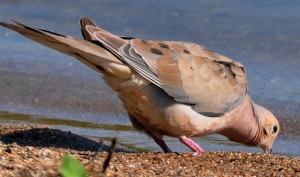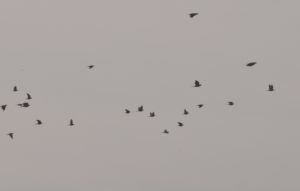Photography courtesy of Lowell Washburn, all rights reserved.
This year’s dove season has been providing local hunters with some pretty good shooting. But during the past couple of mornings, things have tailed off dramatically with fewer and fewer birds showing up in the usual haunts. By early this week, it appeared [and sounded] as if most hunters had packed it in. On Monday, I only got a couple of shots and saw next to nothing for doves. Yesterday morning was worse yet. Birds were so scarce over the foxtail that I only had a shot at one dove and I missed it. Ouch! Things were so slow that, when I woke up this morning, I was almost tempted to sleep in.
As it turned out, sleeping in would have been a big big mistake. Late yesterday afternoon, the wind had turned to the NW. By shortly after daylight this morning, it was becoming increasingly apparent that new doves had been moving on the breeze. Shortly after sunrise, doves began to appear over the same field where none had been the day before. The doves arrived as singles, pairs, trios, and small flocks. During the next half hour, I saw more doves than any day since this year’s season began. Arriving from all directions, the birds were low and stupid. Even after being shot at, some birds would return to buzz the field again — certainly not the kind of behavior we’ve seen from our “educated” doves during the past few days. Although the shooting quickly became hot and heavy, my shotgunning ability was lagging. Before long I began to fear, that for the first time this season, I was going to run out of ammo before I ran out of doves. Actually, I didn’t and left the field with three unspent shells in my pocket. I won’t say how many doves I carried out. I did have enough birds for a meal, and we’ll leave it at that.
The wind is supposed to continue out of the NW on Thursday, and afternoon highs are only supposed to be in the 70s. Anticipation is running high, and tomorrow I’m taking an extra box of shells.
Final Thought: When last week’s dove flight slowed up and shooting grew scarce, most hunters gave it up for the season. But just because doves aren’t showing up in the same old fields doesn’t necessarily mean that you can’t still bag a few — or maybe a lot. Regardless of where they feed, mourning doves still like to take a good drink of water before going to roost each evening. Some areas — like quarries or river sandbars — are more attractive than others and doves often congregate near favored watering holes. I took a comfortable seat in the shade near one of these spots a couple of days ago and was pleasantly surprised by the results. Although it wasn’t exactly like shooting sand grouse over an African watering hole, I was more than pleasantly surprised — amazed actually — over the number of doves that passed within easy range. For some reason, most Iowa dove hunters don’t seem to capitalize on hunting doves over water. It’s something more people should try.



 Susan Judkins Josten
Susan Judkins Josten Rudi Roeslein
Rudi Roeslein Elyssa McFarland
Elyssa McFarland Mark Langgin
Mark Langgin Adam Janke
Adam Janke Joe Henry
Joe Henry Sue Wilkinson
Sue Wilkinson Tom Cope
Tom Cope Kristin Ashenbrenner
Kristin Ashenbrenner Joe Wilkinson
Joe Wilkinson Dr. Tammy Mildenstein
Dr. Tammy Mildenstein Sean McMahon
Sean McMahon